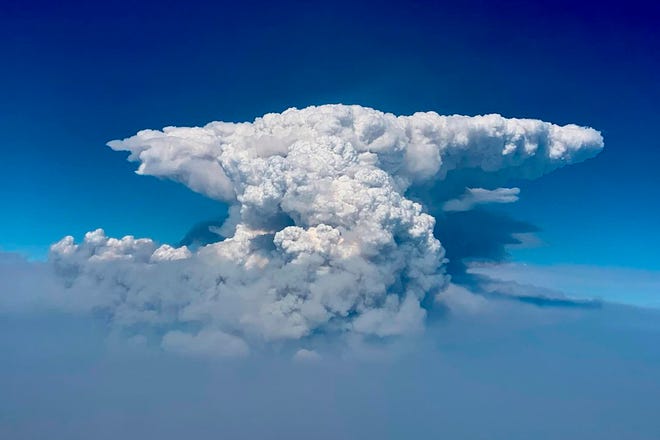
- More than 80 current wildfires were burning through 1,157,976 acres in 13 states.
- 20,000 firefighters are battling the blazes.
- 'Fire clouds' and dry lightning add to misery.
Pacific Gas & Electric said Sunday that its equipment may have been involved in the start of the Dixie Fire burning in the Sierra Nevada, the nation’s largest utility reported to California regulators.
The utility said in a filing Sunday that a repair man responding to a circuit outage July 13 spotted blown fuses in a conductor atop a pole, a tree leaning into the conductor and fire at the base of the tree.
PG&E equipment has repeatedly been linked to major wildfires, including the 2018 fire that ravaged Paradise.
The Dixie Fire has grown to 29 square miles, largely in remote wilderness. The utility said investigators with the California Department of Forestry and Fire Protection have collected equipment from the location.
Meanwhile, powerful storms forecast for parts of the drought-stricken West this week could actually do more harm than good as "fire clouds" and dry lightning sweep across a region already dotted with wildfires fueled by parched vegetation, heat and winds.
The storms brought flash flooding to Phoenix and other areas of the Southwest, but less rain is forecast farther north.
"These storms can cause cloud-to-ground lightning and ignite fires," AccuWeather meteorologist Thomas Geiger warned.
More than 80 wildfires were burning through 1,157,976 acres in 13 states, battled by almost 20,000 firefighters. Generally unstable weather conditions could add to the misery in coming days, the National Interagency Fire Center warned.
In North-Central California, the Dixie Fire had burned through 30 square miles and was threatening more than 800 homes and other structures. The remoteness of the fire, along with the steep terrain, was adding to the challenges faced by hundreds of firefighters.
"Thunderstorms with abundant lightning & little rainfall could produce new fire starts," the National Weather Service in Sacramento said.
The fire's edge is just a few miles from the town of Paradise, which burned almost to the ground in a wildfire three years ago that killed 85 people. But the fire was moving away from the town, and no evacuations were ordered or evacuation warnings given as of Monday morning.

Wildfire explodes near Lake Tahoe: Hundreds flee
Large "pyrocumulus clouds" formed over the Dixie Fire, producing a massive smoke column that further increased fire activity, CalFire said in its latest incident report. Pyrocumulus clouds – fire clouds – look like giant, dirty-colored thunderheads that sit atop a massive column of smoke coming up from a wildfire. Often the top of the smoke column flattens to take the shape of an anvil.
In Oregon, the Bootleg Fire also has produced pyrocumulus clouds. That fire has burned almost 500 square miles and is among the largest blazes in Oregon history. Fire authorities say pyrocumulus clouds are forming at 3 p.m. to 5 p.m. each day as the sun penetrates the smoke layer and heats the ground below, creating an updraft of hot air.
The fire, which ignited two weeks ago, remains "very active" and growing because of hot, dry, and breezy conditions, fire officials said in a bleak update late Saturday night.
"Poor humidity recovery at night is contributing to active fire spread," fire managers said. "Robust spread rates are being generated by drought-affected fuels. Expecting similar conditions for the next several days."
Along the California-Nevada border, the Tamarack Fire had burned about 30 square miles. The blaze destroyed a couple of structures and was threatening the tiny California hamlet of Markleeville, population less than 150.
Dena Brown posted on Twitter that her father had been evacuated.
"We just had a 6.0 earthquake recently now this. #prayerrequest #TamarackFire," she wrote.
Contributing: The Associated Press
Source link





